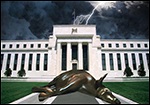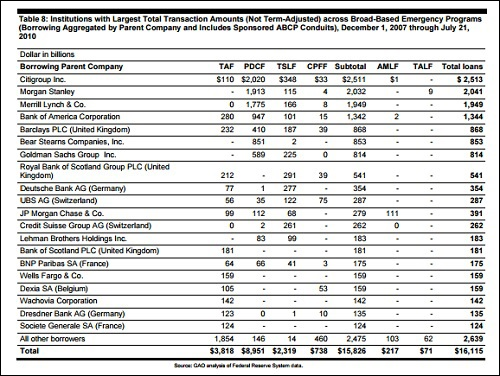By Pam Martens and Russ Martens: March 17, 2022 ~
 Yesterday, it was widely reported in the business press that Saudi Arabia is considering pricing its oil deals with China in China’s own currency, the Yuan, rather than in U.S. Dollars, which is the currency of choice for the bulk of the global oil trade. While it should be noted that this talk has been making headlines for the past four years without actually coming to fruition, the U.S. should stop taking the respected status of the Dollar for granted.
Yesterday, it was widely reported in the business press that Saudi Arabia is considering pricing its oil deals with China in China’s own currency, the Yuan, rather than in U.S. Dollars, which is the currency of choice for the bulk of the global oil trade. While it should be noted that this talk has been making headlines for the past four years without actually coming to fruition, the U.S. should stop taking the respected status of the Dollar for granted.
Three of the key reasons that the U.S. Dollar has been able to maintain its status as the global reserve currency are the following: a stable government which is not subject to being toppled by coups; a large working population which allows federal tax payments to be automatically collected from paychecks in order to pay the nation’s debts on time; and, until 2008, a well-functioning financial system.
The January 6 attack on the U.S. Capitol and its attendant effort to overturn a democratically-held presidential election sent alarm bells around the world as to just how stable the U.S. government really was and whether it would fall into authoritarian hands. The ongoing authoritarian rantings of the Republican right-wing continue to raise alarm bells.
On August 5, 2011 the credit rating agency, Standard and Poor’s, downgraded its U.S. debt rating from AAA to AA+ for the first time in history. S&P has kept that lowered rating on U.S. debt ever since. That sent another chill around the world.
Another alarm has come from actions by the Federal Reserve, the central bank of the U.S., which refuses to provide transparency to the American people and Congress regarding its serial, secret bailouts of the megabanks on Wall Street.
After Wall Street banks crashed the U.S. economy with their derivatives and subprime debt bombs in 2008, the Federal Reserve began pumping trillions of dollars in emergency, cumulative loans into the same banks that had brought down the U.S. economy. But the Fed wouldn’t provide the pubic with the names of the banks and how much each received. Bloomberg News took the Fed to Federal court for more than two years in an effort to get that information. The Fed lost its case at both the Federal District Court and the Appellate Court but still didn’t turn over the details. A coalition of the very banks involved then filed a case with the U.S. Supreme Court to try to stop the release of the information. The Supreme Court refused to hear the case and part of the information was released in late 2010.
Fortunately for democracy, as well as financial transparency in the U.S., Senator Bernie Sanders had the good sense to order an audit of the Fed’s emergency bailout programs by the Government Accountability Office (GAO) and attach it to the Dodd-Frank financial reform legislation of 2010. That GAO audit was released in July 2011 and revealed that the Fed had pumped a cumulative $16 trillion into Wall Street banks from December 2007 to July 2010. (See GAO chart below.) One of those banks, Citigroup, was insolvent for much of that time. When the Levy Economics Institute tallied up the Fed’s dollar swap lines and other Fed bailout programs not covered by the GAO audit, the tally came to $29 trillion in cumulative loans – all conducted in secrecy at the Fed with no vote by the elected members of Congress.
The Fed’s ability to make trillions of dollars in secret loans to its crony banks on Wall Street was supposed to have been reined in by the Dodd-Frank Act in 2010. It wasn’t. All that is actually happening is the Fed is still making the secret loans while the Dodd-Frank Act gives it one year to two years to make the disclosures to the public.
Let’s pause here for a moment. Every U.S. bank that is getting these bailout loans from the Fed is publicly traded. Why should shareholders have to wait one year or two years to find out that their bank needed emergency funding from the Fed. How is that not a materially disclosable event that needs to be made public on a timely basis? Only unseemly cronyism in the upper echelons of the U.S. financial system can explain this.
The legal deadline, under the 2010 Dodd-Frank Act, for releasing the names of the Wall Street firms that borrowed from three emergency bailout facilities the Fed deployed in 2020, and the amounts borrowed, is March 31 of this year. Those facilities are The Primary Dealer Credit Facility (PDCF), the Commercial Paper Funding Facility (CPFF), and the Money Market Mutual Fund Liquidity Facility (MMLF). The Fed has previously released the details of its other 2020 emergency lending facilities, but not these three, which raises more alarm bells.
In addition, on March 31, the Fed is also required to release the names of the banks and amounts borrowed under its emergency repo loan operations for the first quarter of 2020. The Fed began those emergency repo loan operations on September 17, 2019, months before there was any pandemic to blame for a financial crisis on Wall Street. The Fed has been releasing the details of those repo loans that stretched into July of 2020 on a quarterly basis, obstructing the public from seeing the full picture in one comprehensive report.
Equally alarming and raising more questions about the strength of U.S. democracy, there has been a complete news blackout by mainstream media when the Fed releases these alarming bailout details that names the banks and the astronomical sums they borrowed. See our report of January 3: There’s a News Blackout on the Fed’s Naming of the Banks that Got Its Emergency Repo Loans; Some Journalists Appear to Be Under Gag Orders.
In addition to releasing the data in dribs and drabs to obscure a clear picture, the Fed is further obfuscating which banks needed the largest bailouts by having conducted numerous term repo loans of 14, 28 and 42 days with its regular one-day repo loans. (The Fed also included in its data release its unrelated reverse repo loans, which have to be manually removed, in order to calculate just its repo bailout loans.)
When we tallied the Fed’s “trade amount” column for its emergency repo loans in the fourth quarter of 2019, the total came to $4.5 trillion in cumulative loans. But when we set up a new column that adjusted the loans by the number of days in the term, the Fed’s cumulative repo loans for the fourth quarter of 2019 came to $19.87 trillion, or 4.4 times the “trade amount” column.
Just six trading houses received 62 percent of that $19.87 trillion: Nomura Securities, $3.7 trillion; J.P. Morgan Securities, $2.59 trillion; Goldman Sachs, $1.67 trillion; Barclays Capital $1.48 trillion; Citigroup Global Markets, $1.43 trillion; and Deutsche Bank Securities, $1.39 trillion. The parents of three of those firms, JPMorgan Chase, Citigroup and Goldman Sachs, are shareowners of the New York Fed. The New York Fed is the regional Federal Reserve bank that handled the bulk of the 2008 secret bailout loans as well as the bulk of the 2019-2020 secret bailout loans.
The New York Fed is also a banking “supervisor” of JPMorgan Chase, Citigroup and Goldman Sachs – all of which have been charged by the U.S. Department of Justice with criminal felonies. (See our report: New Questions Emerge: Is the New York Fed Working for the American People or the Wall Street Banks that Own It?)
If this all starts to sound like the U.S. financial system has fallen into the hands of a dangerous kleptocracy, you have very valid reasons to draw that conclusion.
As the situation in Ukraine should starkly show every American, democracy cannot be a spectator sport. Americans need to immediately engage in their own democracy and root out the corruption in the U.S. financial system and the cronyism in Washington that perpetuates it.


